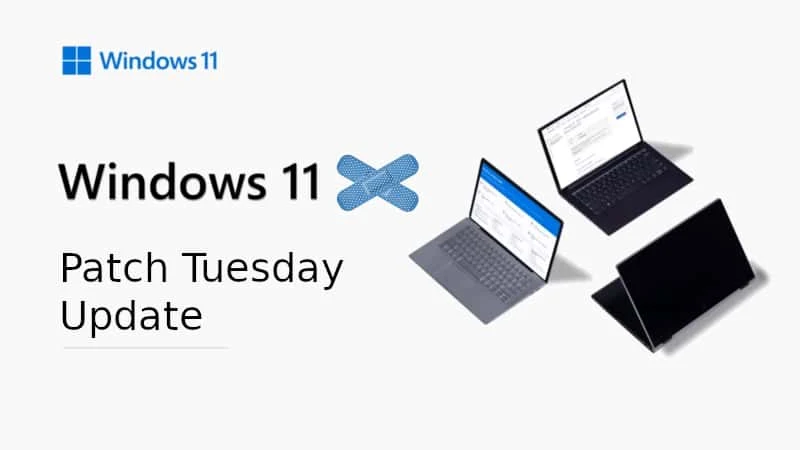As it is the second Tuesday of the month, it's time for patching all supported versions of Microsoft Windows operating systems. Being the ninth patch of the year, Microsoft now started rolling out the Windows 11 September 2022 Patch Tuesday (KB5017328) update for Windows 11 version 21H2, and Windows 10 September 2022 Patch Tuesday (KB5017308) update for versions 20H2, 21H1, and 21H2.
Windows 11 Patch Tuesday (KB5017328) update contains all fixes from the previous optional updates and also includes a few security fixes. To know more about the fixes in this build, and to download the Windows 11 KB5017328 update offline installer, continue reading further.

Windows 11 update KB5017328 - what's new and improved
Addresses a known issue that affects Microsoft accounts (MSA). The web dialog that you use to sign in or sign out might not appear. This issue occurs on devices that have installed KB5016691.
Apart from this, the Windows 11 KB5017328 update also addresses the following issues and improvements that were a part of the previous optional preview update:
New improvements in Windows 11
- New! Gives IT admins the ability to remotely add languages and language-related features. Additionally, they can now manage language scenarios across several endpoint managers.
- New! Compresses a file regardless of its size if you have configured Server Message Block (SMB) Compression.
- New! Enhances Microsoft Defender for Endpoint’s ability to identify and intercept ransomware and advanced attacks.
Other improvements and fixes
- Addresses an issue that causes ServerAssignedConfigurations to be null in a few full configuration scenarios.
- Addresses an issue that affects the automatic high dynamic range (Auto HDR) feature for cross-adapter resource scan-out (CASO)-capable GPU drivers.
- Addresses a known issue that causes Microsoft Edge to stop responding when you use IE mode. This issue also prevents you from interacting with a dialog.
- Addresses an issue that prevents virtualized App-V Microsoft Office applications from opening or causes them to stop working.
- Addresses an issue that might cause the deployment of the Windows Hello for Business certificate to fail in certain circumstances after you reset a device.
- Addresses multiple issues related to USB printing such as:
- A printer malfunctions after you restart or reinstall it
- Being in the wrong mode after you switch from an Internet Printing Protocol (IPP) Class Driver to an independent hardware vendor (IHV) driver
- Experiencing bidirectional communication issues that prevent you from accessing device features
- Addresses an issue that affects the ProjectionManager.StartProjectingAsync API. This issue stops some locales from connecting to Miracast Sinks.
- Addresses an issue that degrades BitLocker performance.
- Addresses an issue that prevents Windows 11 SE from trusting some Microsoft Store applications.
- Addresses an issue that prevents HyperVisor Code Integrity from being enabled automatically on systems that have Arm64 processors.
- Addresses an issue that stops non-Windows devices from authenticating. This issue occurs when they connect to a Windows-based remote desktop and use a smart card to authenticate.
- Addresses an issue that causes the Resultant Set of Policy tool (Rsop.msc) to stop working when it processes 1,000 or more “File System” security settings.
- Addresses an issue that causes the Take a Test app to remove all policies related to lockdown enforcement when you close the app.
- Addresses an issue that causes the Settings app to stop working on server domain controllers (DCs) when accessing the Privacy > Activity history page.
- Addresses an issue that might cause certain Bluetooth audio headsets to stop playing after a progress bar adjustment. This issue affects modern systems that support Advanced Audio Distribution Profile (A2DP) offload.
- Addresses an issue that prevents devices from receiving an offer from Windows Update for the same extension driver when that extension driver is already installed without the base driver.
- Addresses a race condition that causes the Local Security Authority Subsystem Service (LSASS) to stop working on Active Directory domain controllers. This issue occurs when LSASS processes simultaneous Lightweight Directory Access Protocol (LDAP) over Transport Layer Security (TLS) requests that fail to decrypt. The exception code is 0xc0000409 (STATUS_STACK_BUFFER_OVERRUN).
- Addresses an issue that affects a lookup for a nonexistent security ID (SID) from the local domain using read-only domain controller (RODC). The lookup unexpectedly returns the STATUS_TRUSTED_DOMAIN_FAILURE error instead of STATUS_NONE_MAPPED or STATUS_SOME_MAPPED.
- Addresses an issue that might cause the Local Security Authority Server Service (LSASS) to leak tokens. This issue affects devices that have installed Windows updates dated June 14, 2022 or later. This issue occurs when the device performs a specific form of service for user (S4U) in a non-Trusted Computing Base (TCB) Windows service that runs as Network Service.
How to download Windows 11 KB5017328 update (offline installer)
If your Windows Update service is enabled, you should have received this update notification. If not, open the Windows 11 Settings app, navigate to Windows Update and click the "Check for Updates" button.
If you own multiple Windows 11 devices or if you would like to patch the systems manually, you can download the offline installer by clicking here. This is an official direct download link for Windows 11 KB5017328 update.




